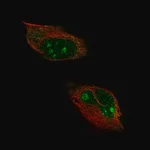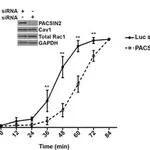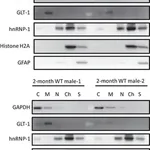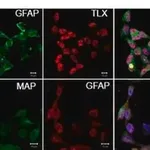
✨AI 추천 연관 상품
AI가 분석한 이 상품과 연관된 추천 상품들을 확인해보세요
연관 상품을 찾고 있습니다...
Anti-GAPDH Antibody
from chicken, purified by affinity chromatography
glyceraldehyde 3-phosphate dehydrogenase, aging-associated gene 9 protein, glyceraldehyde-3-phosphate dehydrogenase
Glyceraldehyde 3-phosphate dehydrogenase (GAPDH) is an ubiquitous glycolytic enzyme present in reasonably high levels in almost all tissues. As a ′house-keeping′ enzyme, it catalyzes the synthesis of 1,3-biphosphoglycerate, a high energy intermediate used for the synthesis of ATP. Besides its cytoplasmic action in metabolism it is also involved in the initial stages of apoptosis or oxidative stress response where GAPDH is translocated to the nucleus. Such actions may reflect the role of GAPDH in DNA repair or as one nuclear carrier for apoptotic molecules. GAPDH has also been found to bind specifically to proteins implicated in the pathogenesis of a variety of neurodegenerative disorders including the beta-amyloid precursor protein and the huntingtin protein where decreased function of GAPDH is associated with Alzheimer′s and Huntington′s disease fibroblasts. GAPDH has also been identified as a potential target for nitric oxide (NO)-mediated cellular toxicity. The complete and functional enzyme is a tetramer with each of four identical subunits occupying the vertex of a tetrahedron. Binding domains also include one principally interacting with NAD+ and another interacting with glyceraldehyde 3-phosphate (GAP).
🏷️Merck Sigma 상품 둘러보기
동일 브랜드의 다른 상품들을 확인해보세요
배송/결제/교환/반품 안내
배송 정보
| 기본 배송비 |
| 교환/반품 배송비 |
|
|---|---|---|---|
| 착불 배송비 |
| ||
| 교환/반품 배송비 |
| ||
결제 및 환불 안내
| 결제수단 |
|
|---|---|
| 취소 |
|
| 반품 |
|
| 환급 |
|
교환 및 반품 접수
| 교환 및 반품 접수 기한 |
|
|---|---|
| 교환 및 반품 접수가 가능한 경우 |
|
| 교환 및 반품 접수가 불가능한 경우 |
|
교환 및 반품 신청
| 교환 절차 |
|
|---|---|
| 반품 절차 |
|





